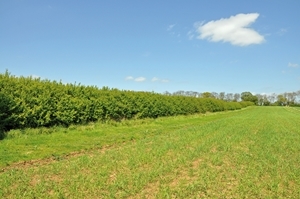 A ground-breaking project to unlock the environmental potential of hedgerows has been given the go-ahead with a government grant of £81,561. The scheme, being developed by the Game & Wildlife Conservation Trust (GWCT) at its demonstration farm, the Allerton Project, will develop a Hedgerow Carbon Code, which will encourage hedgerow habitat improvements and provide a tool to calculate the carbon capture potential of hedgerows. The project is one of just 27 to receive funds from the £10 million Natural Environment Investment Readiness Fund.
A ground-breaking project to unlock the environmental potential of hedgerows has been given the go-ahead with a government grant of £81,561. The scheme, being developed by the Game & Wildlife Conservation Trust (GWCT) at its demonstration farm, the Allerton Project, will develop a Hedgerow Carbon Code, which will encourage hedgerow habitat improvements and provide a tool to calculate the carbon capture potential of hedgerows. The project is one of just 27 to receive funds from the £10 million Natural Environment Investment Readiness Fund.
Hedgerows sequester carbon at twice the rate of woodland because of their three-dimensional structure, and England's hedges already store 9m tonnes of carbon. The proposed Hedgerow Carbon Code will provide an innovative new approach to hedgerows. Similar to the Woodland Carbon Code, the new code will become the quality assurance standard for hedgerows and aims to generate independently verified hedgerow carbon credits.
The code will include a tool which will enable the carbon stored in a hedge to be calculated and verified, incentivising land managers to plant and manage hedgerows – an important part of the government’s new Sustainable Farming Incentive. The tool will also have the potential to be developed further to monitor hedgerow biodiversity for calculating biodiversity credits.
“This award from the Natural Environment Investment Readiness Fund means our team at the Allerton Project, who are experienced in developing nature-based solutions, can push ahead with this innovative project,” said Dr Alastair Leake, Director of The Allerton Project.
“Developing a Hedgerow Carbon Code has huge national potential to enable farmers to increase the amount of carbon stored in their hedgerows and to trade those carbon credits,” continued Alastair. “Applied across a national scale, there is scope to deliver more than £60m of income to the farming community through carbon credits for hedgerow management and planting.”
How will it work?
The size, structure and management regime all influence the amount of carbon stored in hedgerows. Carbon also builds up on the soil surface through hedge leaf-litter and is drawn down and stored in the soil by earthworms. The project team will create a matrix to enable land managers to calculate the contribution each hedge makes to carbon storage and submit their carbon potential for verification under the code.
Incentivising farmers, landowners and councils to maximise the potential of hedges will benefit much more than carbon storage. Well-positioned hedges can reduce surface run-off, improving water quality; remove harmful air pollution; provide flood mitigation and support over 600 different plants, 1,500 insects, 65 birds and 20 mammals species.
Latest figures estimate that there are over 400,000km (250,000 miles) of managed hedgerows in England – 100 times longer than our motorways – with remnants of a further 145,000km of hedges and tree lines. Increasing the height and width of England’s existing hedges has the potential to boost the 9m tonnes of carbon already stored.
Notes to editors
The Game & Wildlife Conservation Trust – providing research-led conservation for a thriving countryside. The GWCT is an independent wildlife conservation charity which has carried out scientific research into Britain’s game and wildlife since the 1930s. We advise farmers and landowners on improving wildlife habitats. We employ more than 60 post-doctoral scientists and other research staff with expertise in areas such as birds, insects, mammals, farming, fish and statistics. We undertake our own research as well as projects funded by contract and grant-aid from Government and private bodies. The Trust also has a dedicated professional advisory service to make sure that the results of its research are easily available to farmers, landowners, gamekeepers, and others delivering practical conservation.
For information, contact:
Eleanor Williams
Telephone: 07592 025476
Email: ewilliams@gwct.org.uk
Notes to editors
The Game & Wildlife Conservation Trust is an independent wildlife conservation charity which carries out scientific research into Britain’s game and wildlife. We advise farmers and landowners on improving wildlife habitats. We employ 22 post-doctoral scientists and 40 other research staff with expertise in areas such as birds, insects, mammals, farming and statistics. We undertake our own research as well as projects funded by contract and grant-aid from Government and private bodies. The Trust is also responsible for a number of Government Biodiversity Action Plan species and is lead partner for grey partridge and joint lead partner for brown hare and black grouse.
The GWCT’s Allerton Project: The GWCT’s Allerton Project is an 800 acre commercial farm business attached to a Research and Educational charitable trust. The Project was established in 1992 with the objective of demonstrating how modern efficient farming and environmental conservation can co-exist. The development of the education objectives of the Trust has expanded substantially to several thousand visitors a year including school groups, politicians and farmers, thus necessitating the construction of a larger visitor centre. The challenge of converting a disused brick cowshed into a sustainable building was given to architect Sylvester Cheung from Melton Mowbray. 60 per cent of construction costs were obtained as a grant from the Rural Development Programme for England.